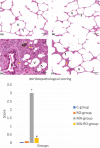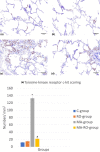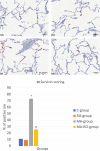Potential of rosmarinic acid to ameliorate toxic effects of diethyl methoxy thio‑phosphoryl thio‑succinate on albino wistar rats' lung, mast cell infiltration inhibitory pathway
- PMID: 34262720
- PMCID: PMC8269576
- DOI: 10.1002/fsn3.2316
Potential of rosmarinic acid to ameliorate toxic effects of diethyl methoxy thio‑phosphoryl thio‑succinate on albino wistar rats' lung, mast cell infiltration inhibitory pathway
Abstract
Malathion (MA) is a widely used pesticide in agriculture. It can cause toxicity in different organs of the body. Rosmarinic acid (RO) is found in rosemary extract that can be absorbed through gastrointestinal tract mucosa with potent antioxidant, and anti-inflammatory potential. The current study is designed to investigate the potential of RO to protect the lung after MA administration. Forty albino rats were allocated equally to four groups. C-group received corn oil. RO-group received RO orally. MA-group received MA. MA-RO-group received RO in addition to MA. After three weeks the lungs were dissected for histopathological and biochemical investigations. MA-group showed manifestations of severe inflammation with inflammatory cells infiltration in the lung. MA-RO-group showed limited inflammatory cell infiltration. C-group and RO-group appeared with weak anti-survivin immunoreactivity. MA-group showed strong positive immunoreactivity. The reactivity was weakly positive in MA-RO-group. MA-group showed a significant decrease in SP-D gene expression in comparison to the C-group, in addition, MA-RO-group showed a significant increase in SP-D expression. In conclusion, the current study approves that oral administration of MA causes lung injury as it has inflammatory effects, caused by oxidative stress and reports the potential of RO to protect lung tissue against toxic effects of MA through its anti-inflammatory, antioxidant, and anti-apoptotic potential.
Keywords: SP‐D gene; lung; malathion; mast cell; rosmarinic acid.
© 2021 The Authors. Food Science & Nutrition published by Wiley Periodicals LLC.
Conflict of interest statement
Authors have declared that no competing interests exist.
Figures




References
-
- Akbel, E. , Arslan‐Acaroz, D. , Demirel, H. , Kucukkurt, I. , & Ince, S. (2018). The subchronic exposure to malathion, an organophosphate pesticide, causes lipid peroxidation, oxidative stress, and tissue damage in rats: The protective role of resveratrol. Toxicology Research, 7(3), 503–512. 10.1039/C8TX00030A - DOI - PMC - PubMed
-
- Amara, I. , Soudani, N. , Troudi, A. , Hakim, A. , Zeghal, K. , Boudawara, T. , & Zeghal, N. (2012). Dimethoate induced oxidative damage and histopathological changes in lung of adult rats: Modulatory effects of selenium and/or vitamin E. Biomedical and Environmental Sciences, 25(3), 340–351. - PubMed
-
- Amenomori, S. , Terasaki, Y. , Terasaki, M. , Urusiyama, H. , Takahashi, M. , & Kunugi, S. (2011). The increased expression of survivin on lipopolysaccharaide (LPS)‐induced acute lung injury (ALI) in mice. American Journal of Respiratory and Critical Care Medicine, 183, 2098–2099.
LinkOut - more resources
Full Text Sources
Research Materials

